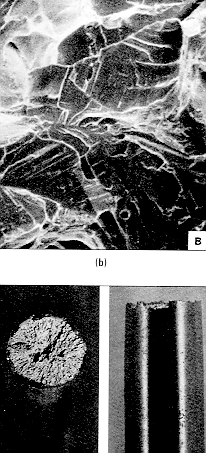|
The
photograph shows the result of a brittle fracture process in a low-carbon
steel tested at low temperature. The top photograph is a microscopic view
of the fracture surface, and the lower pair of photographs show the sample
after fracture. The fracture surface is normal to the applied tensile stress
in the sample and each "grain" in the polycrystalline metal sample may
fail along its boundary with neighboring grains (intergranular fracture)
or fail through its bulk on particular crystal planes (transgranular fracture).
Fracture in this mode is associated with rapid crack propagation through
the material and a "critical crack length" is associated with failure at
a given stress through the Griffith criterion that was developed for glass-like
materials. This states that:
sC
= (2Eg/pc)0.5
where sC
is the critical stress, E
is Young's modulus,
g
the surface energy of the crack, and c
the length of the critical crack in the material. The surface energy may
be extended to include any additional work that is done in near crack surface
plastic deformation in less brittle materials such as metals. |
|
|
|
